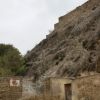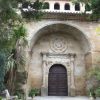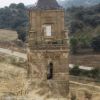The undulating form of the Clamor canyon is dotted with sandstone rocks that have been rounded off and made smooth by the effects of erosion of millions of years. This has given rise to an unusual landscape. Some of the rocks are unique and are the base of legends such as the story of the appearance of Santa Lucia. Others were used as lookout points and fortresses like the outcrop of Santa Margarita.
Azara has a Moorish past similar to that of the neighbouring villages of Abiego, Azlor and Peraltilla and, like them, was also conquered by the troops of Pedro I in the year 1095. This rich history can be seen in the remains of its fortress and parish church, both of which date back to the 16th century and follow the principals of the late Gothic style.
The name Azara has a pleasant ring as do the older versions of the name; Azar, Azahara, Assara and Zaara. All hint at a peaceful and sunny spot with a gentle landscape and a tapestry of cultivated fields. These small plots, located between rolling hills, are dedicated to the cultivation of cereals, almonds, vines and olives. Fertile allotments are irrigated thanks to ingenious methods of collecting water. Deep “tanks” have been excavated from nearby rocks in order to store rainwater. In addition, and a number of wells still bring water to the surface via an old wooden lever system typical of this area known as the ceprénes.
The village of Azara is concentrated in one main street that runs from the church of Santa Lucia to the square. Another road leads to a more modern, gardened area. A stroll through the streets reveals a number of attractive old houses made from stone and brick, with beautifully constructed semicircular doorways. These houses are typical of the region and always incorporated a place to make and store wine, which would come to the light full of aroma and colour after a long and peaceful rest in dark cellars.






